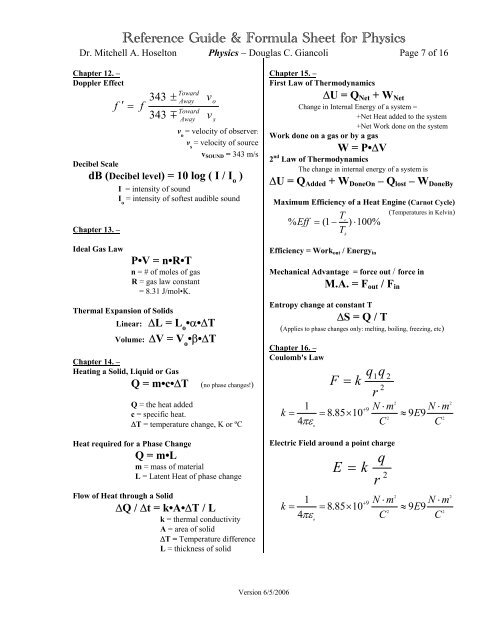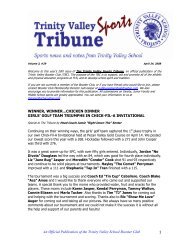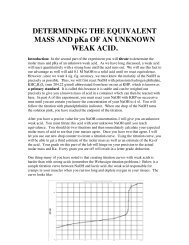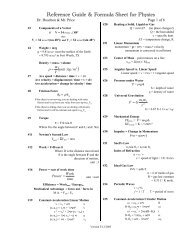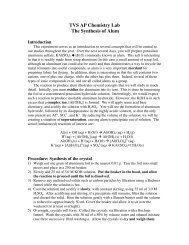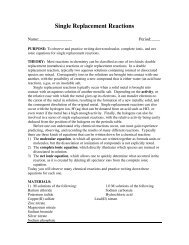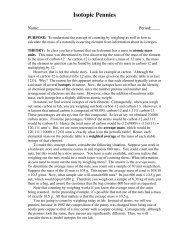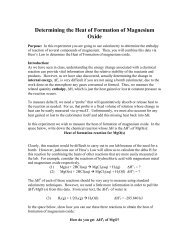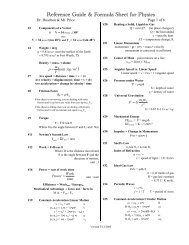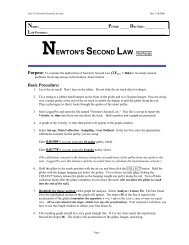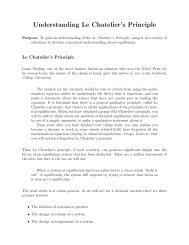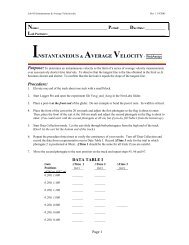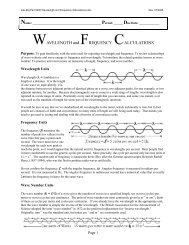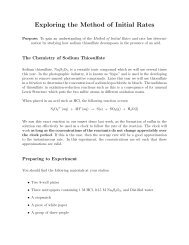Reference Guide & Formula Sheet for Physics - 2006 Version
Reference Guide & Formula Sheet for Physics - 2006 Version
Reference Guide & Formula Sheet for Physics - 2006 Version
You also want an ePaper? Increase the reach of your titles
YUMPU automatically turns print PDFs into web optimized ePapers that Google loves.
<strong>Reference</strong> <strong>Guide</strong> & <strong>Formula</strong> <strong>Sheet</strong> <strong>for</strong> <strong>Physics</strong><br />
Dr. Mitchell A. Hoselton <strong>Physics</strong> − Douglas C. Giancoli Page 7 of 16<br />
Chapter 12. –<br />
Doppler Effect<br />
f<br />
v o<br />
= velocity of observer:<br />
v s<br />
= velocity of source<br />
v SOUND = 343 m/s<br />
Decibel Scale<br />
dB (Decibel level) = 10 log ( I / I o<br />
)<br />
I = intensity of sound<br />
I o<br />
= intensity of softest audible sound<br />
Chapter 13. –<br />
Ideal Gas Law<br />
′ =<br />
Toward<br />
Away<br />
Toward<br />
Away<br />
P•V = n•R•T<br />
n = # of moles of gas<br />
R = gas law constant<br />
= 8.31 J/mol•K.<br />
Thermal Expansion of Solids<br />
Linear: ∆L = L o<br />
•α•∆T<br />
Volume: ∆V = V o<br />
•β•∆T<br />
Chapter 14. –<br />
Heating a Solid, Liquid or Gas<br />
Q = m•c•∆T<br />
f<br />
343 ±<br />
343<br />
m<br />
v<br />
v<br />
(no phase changes!)<br />
Q = the heat added<br />
c = specific heat.<br />
∆T = temperature change, K or ºC<br />
o<br />
s<br />
Chapter 15. –<br />
First Law of Thermodynamics<br />
∆U = Q Net + W Net<br />
Change in Internal Energy of a system =<br />
+Net Heat added to the system<br />
+Net Work done on the system<br />
Work done on a gas or by a gas<br />
W = P•∆V<br />
2 nd Law of Thermodynamics<br />
The change in internal energy of a system is<br />
∆U = Q Added + W DoneOn – Q lost – W DoneBy<br />
Maximum Efficiency of a Heat Engine (Carnot Cycle)<br />
Tc<br />
% Eff = (1 − ) ⋅100%<br />
T<br />
Efficiency = Work out / Energy in<br />
(Temperatures in Kelvin)<br />
Mechanical Advantage = <strong>for</strong>ce out / <strong>for</strong>ce in<br />
M.A. = F out / F in<br />
Entropy change at constant T<br />
∆S = Q / T<br />
(Applies to phase changes only: melting, boiling, freezing, etc)<br />
Chapter 16. –<br />
Coulomb's Law<br />
h<br />
F = k<br />
k = = 8.85×<br />
10<br />
4πε<br />
q<br />
1 + 9<br />
o<br />
1 2<br />
2<br />
r<br />
q<br />
N ⋅ m<br />
2<br />
C<br />
2<br />
N ⋅ m<br />
≈ 9E9<br />
2<br />
C<br />
2<br />
Heat required <strong>for</strong> a Phase Change<br />
Q = m•L<br />
m = mass of material<br />
L = Latent Heat of phase change<br />
Flow of Heat through a Solid<br />
∆Q / ∆t = k•A•∆T / L<br />
k = thermal conductivity<br />
A = area of solid<br />
∆T = Temperature difference<br />
L = thickness of solid<br />
Electric Field around a point charge<br />
E = k<br />
1 + 9<br />
k = = 8.85×<br />
10<br />
4πε<br />
o<br />
r<br />
q<br />
2<br />
N ⋅ m<br />
2<br />
C<br />
2<br />
N ⋅ m<br />
≈ 9E9<br />
2<br />
C<br />
2<br />
<strong>Version</strong> 6/5/<strong>2006</strong>


